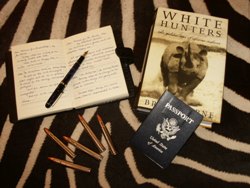

 The Accurate Reloading Forums
The Accurate Reloading Forums  THE ACCURATE RELOADING.COM FORUMS
THE ACCURATE RELOADING.COM FORUMS  Hunting
Hunting  Hunting Reports - Africa
Hunting Reports - Africa  Congo Forest Safaris - The Forest Experience!
Congo Forest Safaris - The Forest Experience!Go  | New  | Find  | Notify  | Tools  | Reply  |  |
| One of Us |
Congo Forest Safaris: The Forest Experience Operator: Congo Forest Safaris (Jean Luc and Valerie Damy) Professional Hunter: Christophe Morio Travel Agent: Travel with Guns (Agent - Patrick Wright) Visa Agent: G3 Visas Flights: Air France: (Washington (IAD) to Brazzaville with layover in Paris (CDG)) Firearms: Ruger synthetic in 375 Ruger, Beretta over-and-under 12 gauge (camp guns) Game Sought: Bongo, Forest Duikers, Forest (Western) Sitatunga, Dwarf Forest Buffalo Game Taken: Bongo, Forest Sitatunga, Bay Duiker, Peter’s Duiker, Blue Duiker Preamble My first knowledge of hunting in the equatorial forests of Africa came when reading “Where lions roar” by Craig Boddington nearly 18 years ago in December 2001. I remember the dates as the book was a Christmas gift which I had read cover-to-cover by the next day. The entirety of the book was fascinating, however, the chapters on forest safaris lit an inextinguishable fire in my imagination. When I reached a point where such a safari would be possible, it was shortly after Jean Luc Damy (also owner of Atacora Safaris in Benin) opened a new forest concession in the north of Congo, west of Ouesso and bordering southern Cameroon. Furthermore, well known bongo hunter, Christophe Morio, has been hunting this concession, known as TalaTala, for several years. After communicating with Christophe and several recent clients, we made plans for a forest safari in September 2019 to focus on bongo. Republic of Congo (Congo - Brazzaville) If you want to have some interesting conversations and raise some eyebrows, I would recommend telling people you are going to “the Congo”. The typical response is a surprised look, followed by “Why?” The word “Congo” carries an unshakable stigma of darkness and horror often perpetuated by Joseph Conrad’s literary classic, “The Heart of Darkness”. While some is certainly justified with prior events in the region, particularly within the Democratic Republic of Congo (former Zaire) and Central African Republic, many of these stereotypes unfairly get applied to the Republic of Congo (Congo-Brazzaville). The “little Congo” is sandwiched between the DRC to the east and south with Gabon situated to the west. To the north lies Cameroon with the CAR to the northeast. The capital is Brazzaville which lies on the western banks of the mighty Congo river and has a population of around 2 million. Directly across the river is Kinshasha, capital of the DRC, and they constitute the two closest capitals in the world. Congo-Brazzaville is a sparsely populated country with many of its inhabitants living in its two largest cities, Brazzaville and Pointe Noir. The north of the country is extremely sparsely populated due to the expansive forests in the region. Throughout the country most people are French-speaking, similar to much of central Africa. En Route to TalaTala As with any proper remote hunting location, we had a long trip to the camp at TalaTala. Travel in to Congo was a point of apprehension as I have read numerous reports regarding the difficulty with traveling anywhere in central Africa. Happily, I can report that we had no real issues at all with our travels. Once we arrived in Brazzaville, we cleared customs rather quickly with only a minor inquiry regarding an “invitation letter” which I promptly supplied to appease the customs agent. A police officer, who works closely with Congo Forest Safaris, helped us claim our baggage with ease. Jean Luc and Valerie were superb during our travel and travel planning with obtaining the necessary paperwork as well as navigating through the country. Jean Luc and/or Christophe were with us at all points of the safari from arrival to departure. With bags in hand, we met up with Jean Luc, Mike Currie (PH), and another hunter with whom we would share camp with for the safari. In the mean time, we would overnight at GHS hotel in Brazzaville which was quite comfortable with nice restaurant in the lobby. After a much needed night of rest, we were up at dawn to head to the airport for a flight north to Ouesso. Air Congo operates flights within the country several days per week and Jean Luc had made arrangements for us all to fly. The flight north was less than 2 hours with the last half hour showing the shadow of the plane cast onto dense forests below, giving some insight into the forest we would soon hunt. This commercial flight is a wonderful alternative to expensive private charters required in neighboring Cameroon. 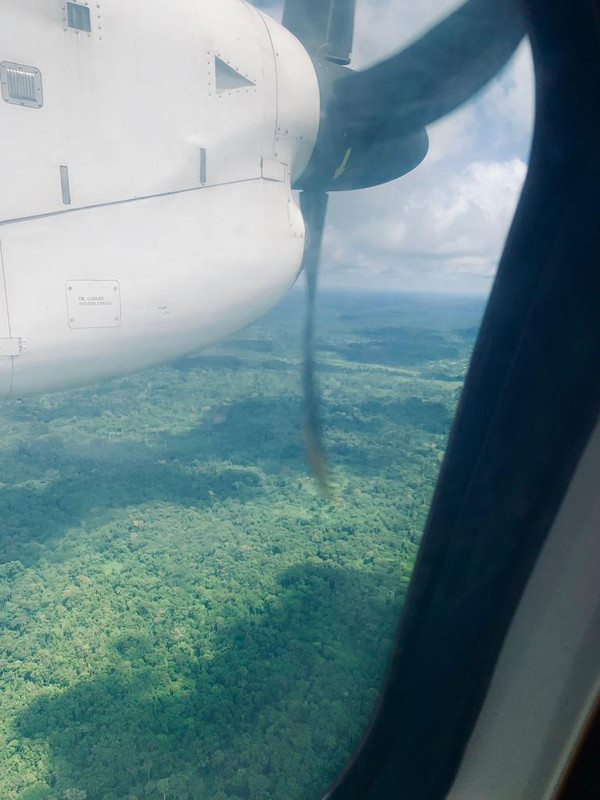 At Ouesso, we were met by Christophe Morio who would be my professional hunter for the safari. I liked Christophe straight away. He has a great sense of humor as well as a contagious enthusiasm and energy for hunting and the forest. On the drive in to TalaTala hunting camp, about 2.5 hours from Ouesso, we discussed many topics but focused on hunting. They had a good rain 2 days ago but otherwise it has been uncharacteristically dry for this time of the year. We hope that the long rainy season will swing in to full force soon. Christophe says, “In England they say, no wind, no pigeon. Here, no rain, no bongo”. Regardless, Christophe is very optimistic about taking a bongo and also would like to spend time hunting forest sitatunga for which he recently constructed several machans. The road in to TalaTala hunting camp was originally made by a Lebanese logging company, although, the roads in the concession are now maintained by the hunting camp. The camp at TalaTala is truly astounding with a superb dining area and well maintained chalets, each equipped with air conditioning and running water. A large deck with fire pit sits on the banks on the Ngoko river which separates Congo and Cameroon. 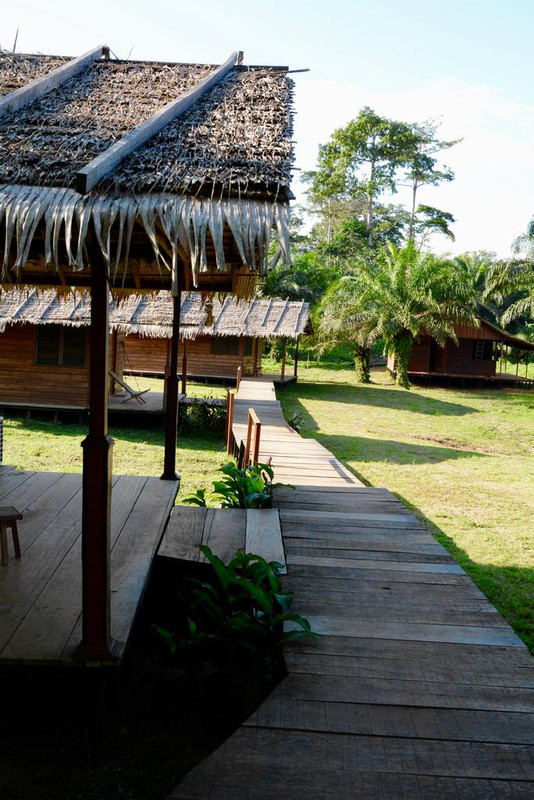 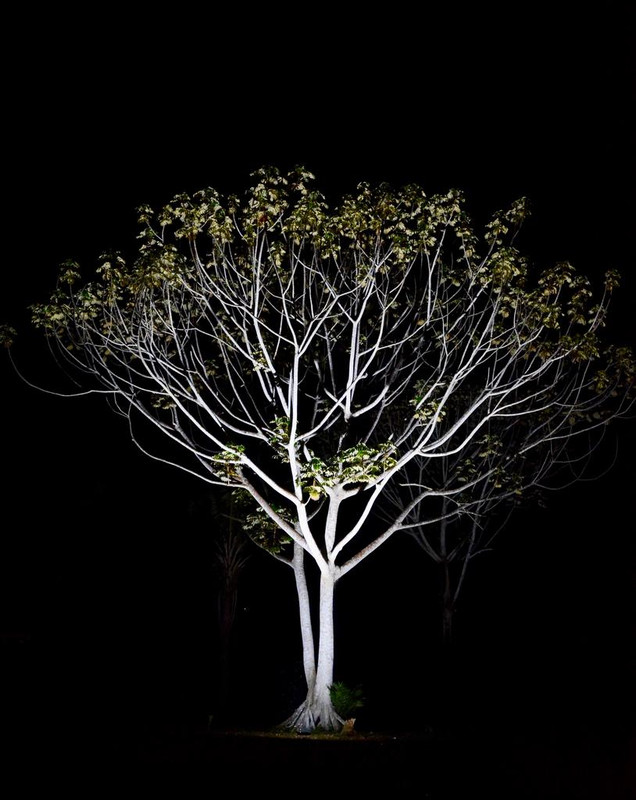 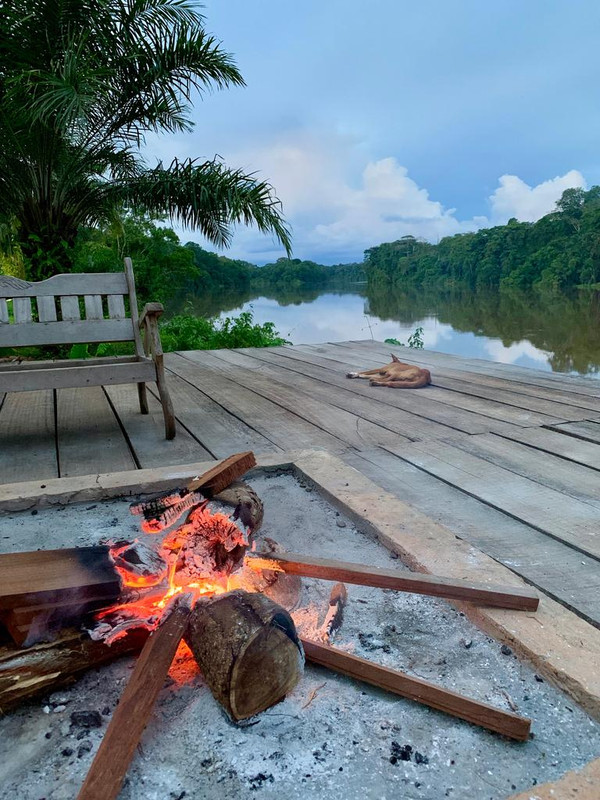 Tomorrow is the first hunting day. We will be on the road at daybreak and the bongo hunting experience will truly begin… Our Hunting Team At the helm is Christophe Morio, well known throughout Africa with considerable experience hunting bongo. He is one of the few, if not the only, PHs to have two bongo over 36 inches to his credit (including one from early this season in the concession we are hunting). 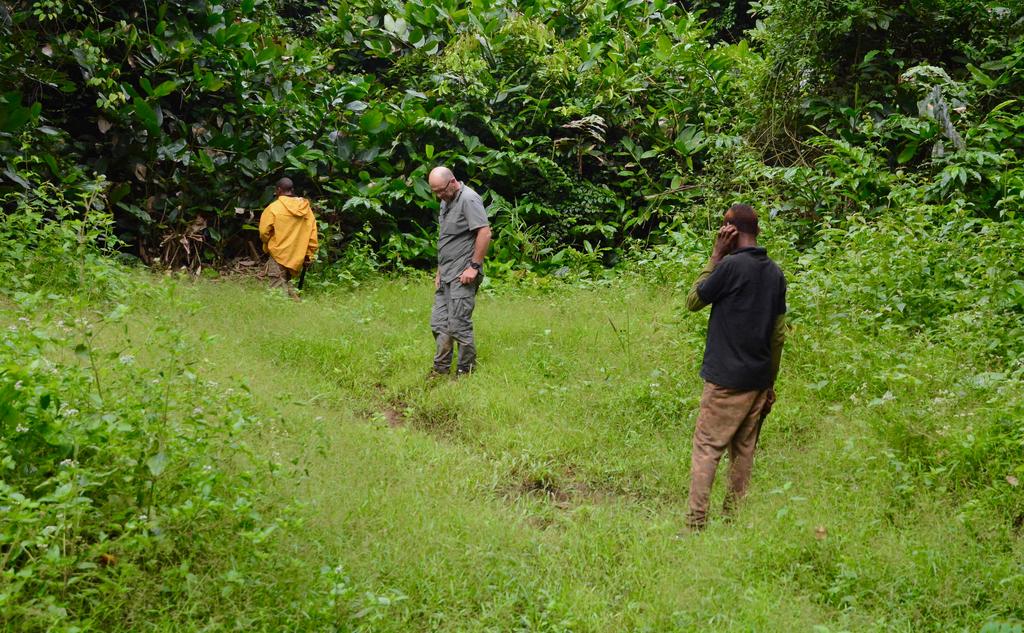 The trackers for the safari are Baka pygmies, true citizens of the forest. Our Baka trackers are Zemako, Tala, Oscar, and Clement with three of their dogs in tow. The Baka predominantly speak French and know no English which makes communicating with them difficult for us. However, there are really pleasant guys with a happy and playful demeanor. Overall, the Baka are a wonder to observe as we worked through the forest. Each day they collect something or find a useful item from the forest ranging from mushrooms to cassava to a certain tree pulp which apparently is used as an erectile stimulant! On nights we sit in the machan, they go fishing with rods made from tree branches. 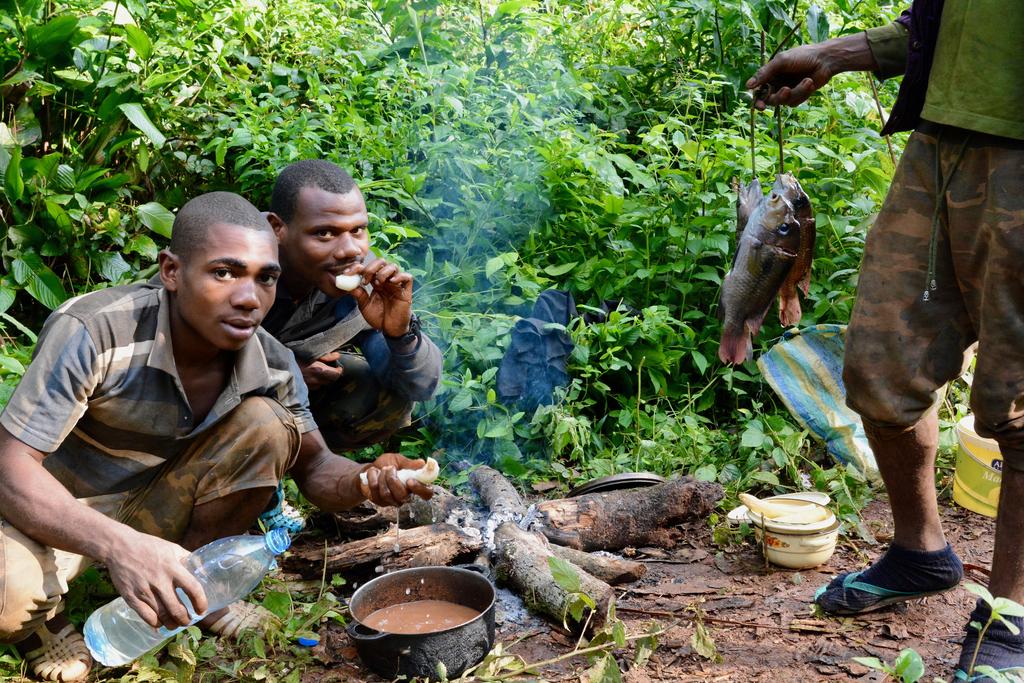 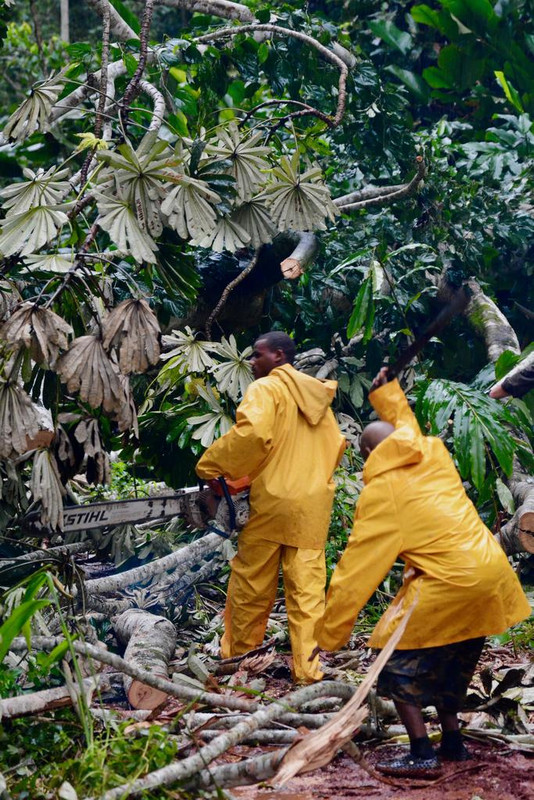 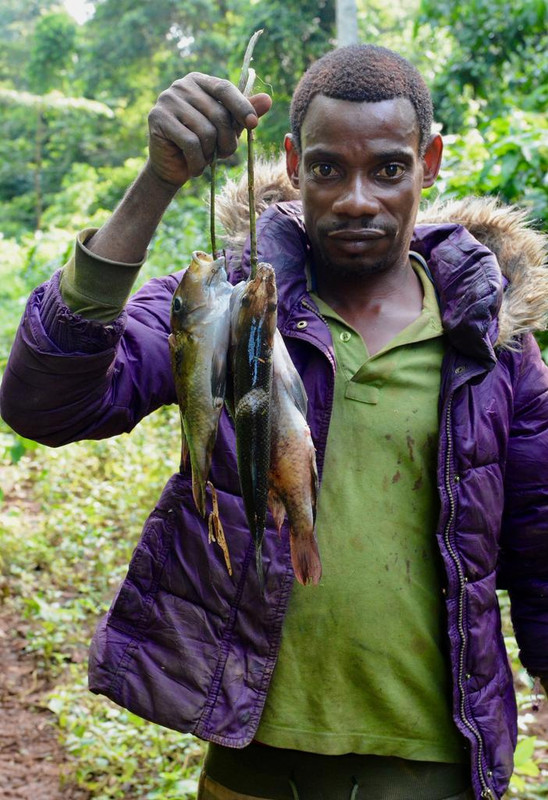 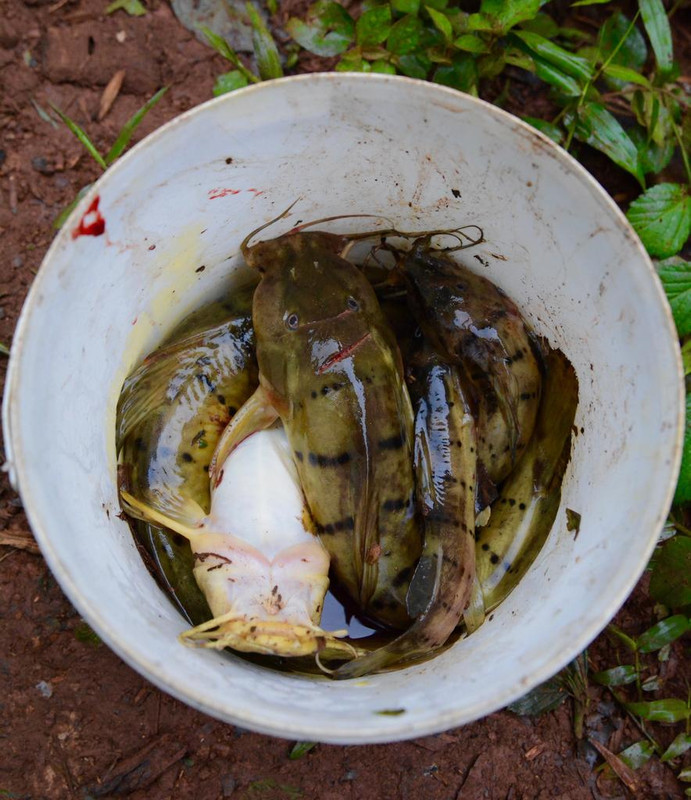 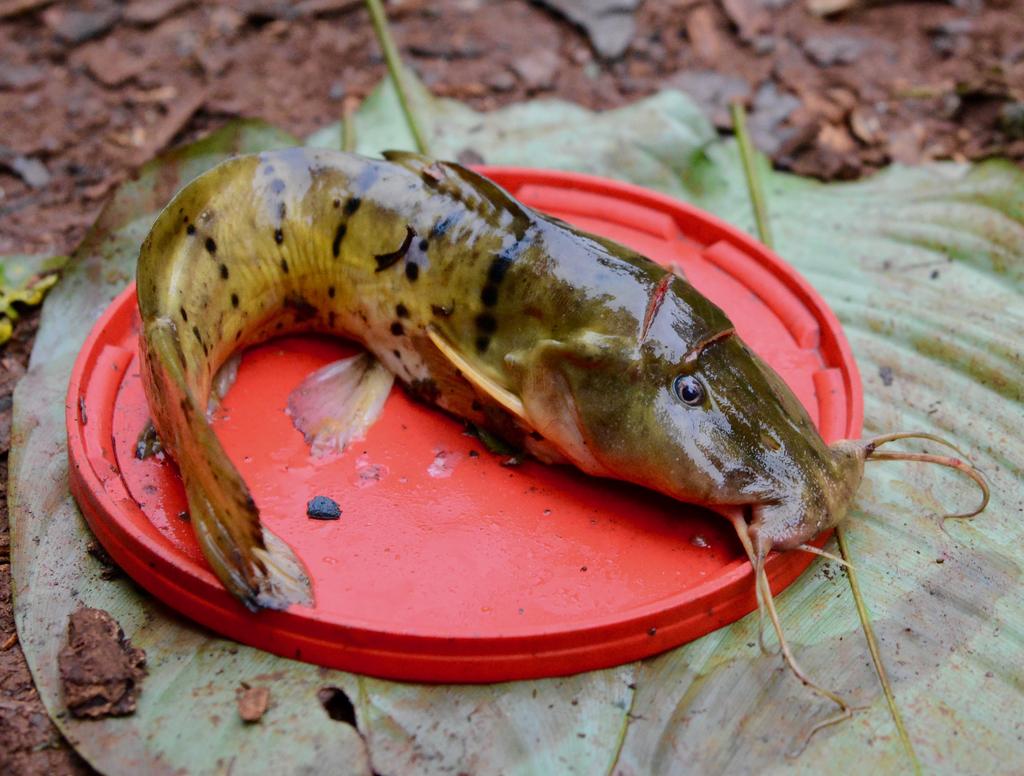 Many Baka live in this area with scattered “houses” along the road. For employment, many of them pick bananas, cassava, and cocoa. Every few days there are large elevated trays of cocoa seeds drying in the sun. We often stop to buy large bunches of bananas for our trackers en route to the hunting area. There are many goats, sheep, and chickens scattered amongst their homes which we dodge with the hunting vehicle on a daily basis.  The hunting dogs are basenjis. They are a small breed but are essential for hunting bongo in the dense forest. I had heard that the dogs were unfriendly, however, I found most of the dogs in camp to be rather personable. It is a tough life to be a dog in this place and Christophe reports that not many live beyond 5 years old. Tattered ears with sores due to relentless flies are almost ubiquitous amongst these guys. These dogs hunt quite differently than bird dogs or dogs running mountain lion. We hunted with 2-3 dogs each day and they remain in close proximity to the trackers at all times. Each group has a “leader” who strays a little further but by my estimation is never more than 50 yards from the hunting team. The dogs are only involved once you have a lone bongo track worth following. The dogs begin to bark once contact is made with the bongo with increased intensity of barking once the bongo is bayed. 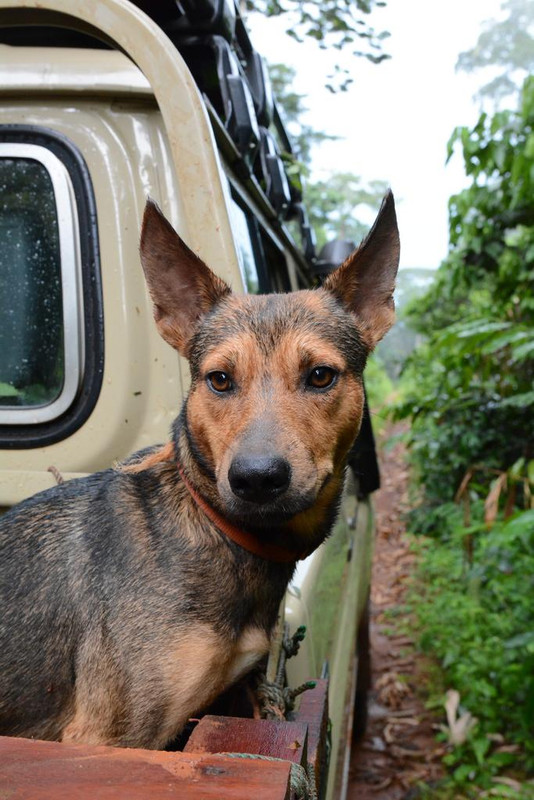 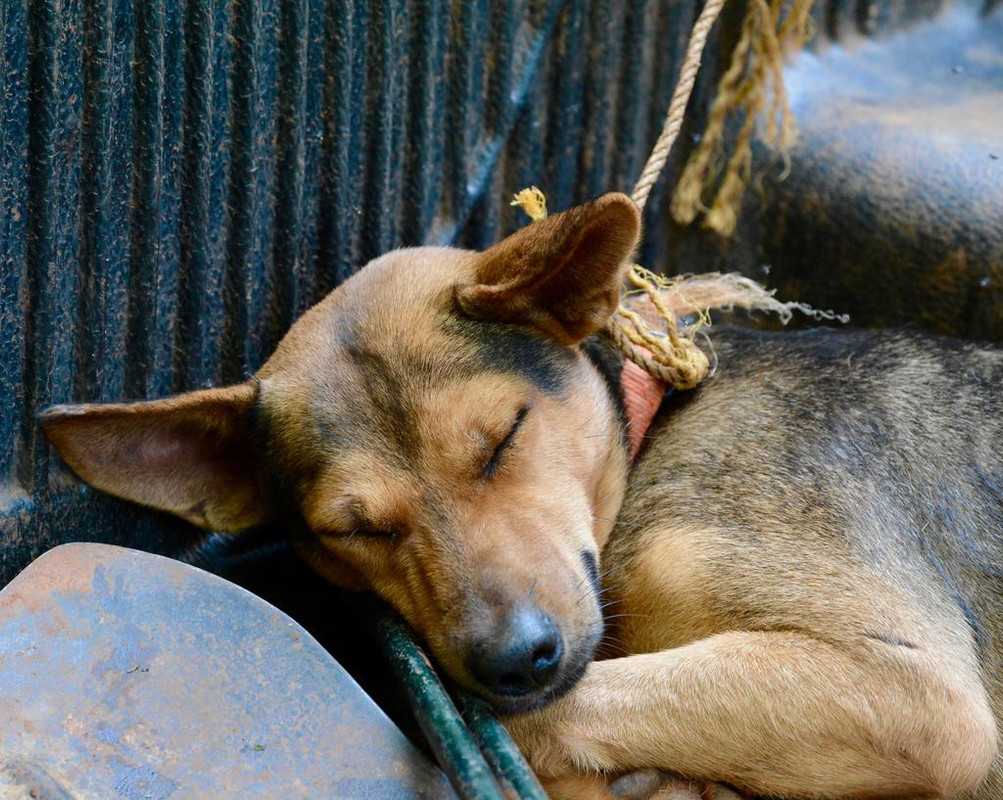 I want to take a moment to emphasize “team”. Truly, a forest safari is a team effort encompassing the Baka, professional hunter, dogs, and lastly, the hunter. Without the expertise of Christophe and forest skills/knowledge of the Baka, hunting here would be impossible for visiting hunters. The Hunting Routine Throughout the safari, we spent time hunting by a number of different means. As I mentioned, the primary goal was a bongo. For optimal tracking conditions, you need a good rain every 3 days or so to give you a blank canvas when checking the roads and salt licks. Much time is spent each day checking the roads and salt licks to look for a worthy bongo track. The goal is to find a lone, large track to follow. Once such a track is located, the Baka slowly navigate through the forest with the dogs in close proximity. The dogs are critical for hunting in this dense forest and serve as a distractor for the bongo until the hunters can reach their location and assess whether the bull is old enough to take. Bongo bulls can respond to the dogs in several ways, run or fight. If the bongo bays/fights, it may stay for up to 15 minutes and the hunters must make haste to reach the site while being vigilant to prevent the bongo from spotting them. Generally, if the bongo sees the hunters he will flee. 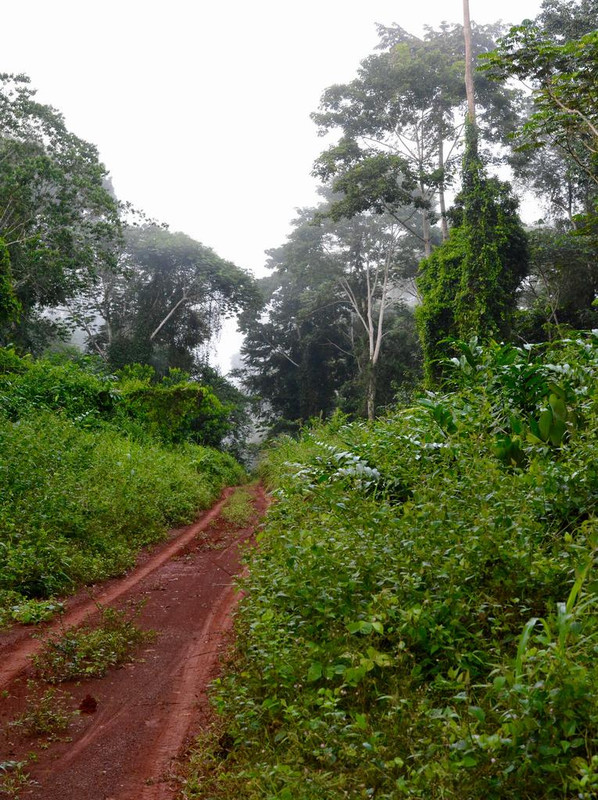 On days when we did not have worthwhile bongo tracks to follow, we spent considerable time hunting duiker. It is a wonderful experience in the forest and we usually spend 3-4 hours weaving deep into the forests. The entire team makes occasional stops against the trunks of mighty ayus trees to call. The Baka call duikers by a high-pitched wheeze which they make by pinching their nose and inhaling deeply and forcefully. The calls serves as a distress call and many subspecies of duikers will respond, including blue, bay, Peter’s, and black-fronted duiker. In this concession, Peter’s duikers are most common followed by blue then bay duiker. With calling, the duikers may make a silent, slow approach or come charging in to assess the situation. It is good fun and we spend a lot of time calling them throughout the safari. Christophe was really excited for the prospect of getting a forest sitatunga which can be hunted several ways. If a fresh track is found they can be tracked with the Baka and dogs similar to the bongo. However, we hunted the sitatunga by sitting in machans (large elevated tree blinds or platforms). When hunting the machans, we generally would get settled in around 3-4 PM and would sit for the entire night for several reasons. First, it allowed us to capitalize on last light and first light of the hunting days as these forest sitatunga do not move much during the day. Secondly, the machans we hunted were at the far end of a 28 km road which we hunted. So, we would sleep overnight in the machan, hunt the first 1-2 hours of daylight from the machan, then we would be able to scour the entire 28 km stretch of road for bongo. Afternoons in the machan were generally very hot and humid with each occupant remaining shirtless until the sun set. During those first few hours it was like a Hopi sweat lodge and we awaited sitatunga to appear from the swamp or for our spirits animals to manifest! Christophe’s strategy with the machans maximized our hunting time and as you will read later, most certainly maximized our success! 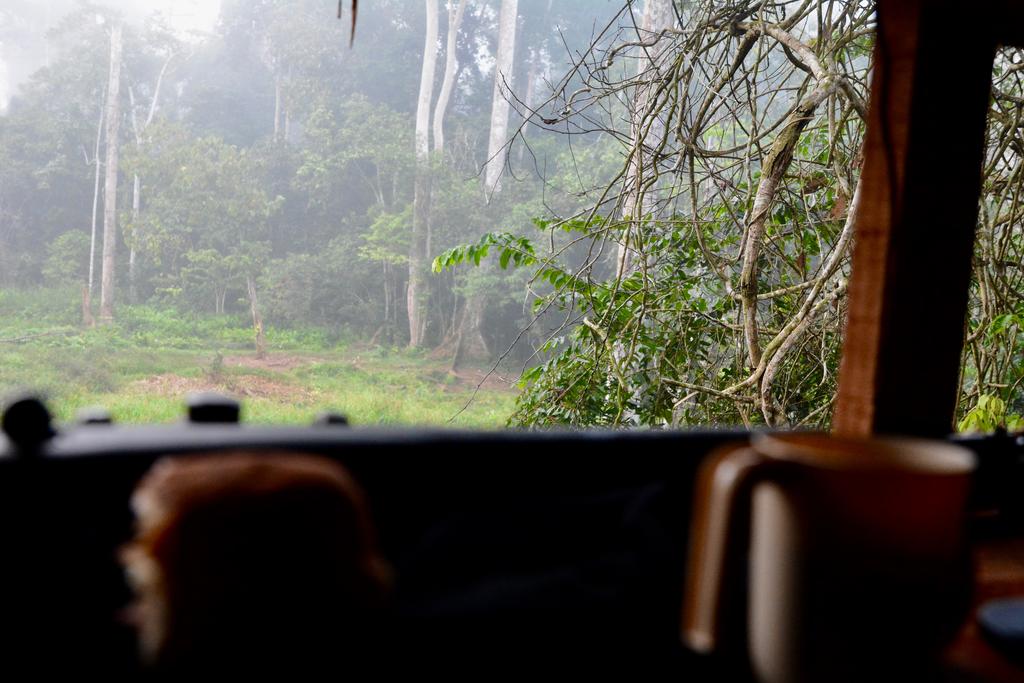 From this point forward, I will break the report up in to segments by species we hunted. I took extensive notes and made multiple daily journal entries throughout the trip, however, it is a little long-winded so I will give you guys an abridged version with pertinent events of the safari. The Bongo Despite having adequate rain, the first 5 hunting days are very slow in regards to finding fresh bongo sign. One day we find a decent track but the bull quickly joined up with a herd and we called off the search. Otherwise, we had seen a lot of fresh buffalo sign the first 5 days but will remained focused on bongo for the time being. On day 6, the second day after the last good rain, we head out to the long stretch of road we have been hunting all week. Many people with forest experience will tell you that the second day after a good rain is often the best so we are optimistic. Within the first few kilometers, it is clear that something is different today. We see multiple bongo, buffalo, and gorilla tracks which are all fresh. The first set of bongo tracks consists of a small herd, although, contains a good track. However, we need a lone bull track. A short distance up the road we find a lone bongo track, he fed along the road last night. “I like this track”, reports Christophe. “The front track is wide, round, and deep. It is a good track”. The Baka sort out where the bongo re-entered the forest and off we go. Much to my surprise, a dog begins barking only minutes into our tracking. At first a lone bark, however, the intensity escalates rapidly. Then our other dog chimes in…”we must go”. We quickly circle an impassable thicket to reach the dogs and find the dogs circling a fighting bongo bull. The massive animal seems quite out of place in this dense forest. After a quick look I hear, “He’s good, shoot him”. Often when you read of bongo hunting, you do not hear much (or at least much detail) about the shooting conditions. In part, this is likely due to the short distances involved; our bull was a “long” shot for bongo at 13 meters. However, do not discount some of the difficulties due to the minuscule distances involved. I could see the entire bull; a rare circumstance in that I could see the entirety of the bull at all times. However, he was spinning circles while fighting the dogs at his head and rear. In this situation one must remain vigilant during the chaos with special care to make sure the dogs are clear from the shooting lanes. Also, the Baka are just as excited as the dogs and you must be sure that they have not crept too far forward during the proceedings. Only briefly would the bull pause as I tried to organize a sight picture between three saplings directly in my line of sight. With one pause, I lined up the crosshairs and as the trigger broke he began to spin again with the bullet hitting mid-ship. Still spinning, I reload and take aim again. The bull then quarters towards us with head down, still distracted by the dogs, and things come in to view. As his head turns left to right, his right horn clears the shoulder and the recoil brings a surprise. Perfect! On the point of the shoulder and angling through the bull…he drops at the shot. A celebration erupts! After 5 days of slow hunting, things came together rapidly this morning with our bull down by 6:55 AM. High fives, handshakes, and hugs all around as the Baka sing…an indescribable experience! I am so thankful that my father could be here to share the experience. The Baka describe our bull as “mondoutou”, which roughly translates into massive body. The neck circumference tapes out at 45.5 inches! As I look at him on the ground, the body morphology more closely resembles a fighting bull than an antelope. “I knew by the color of his horns. When their horns become amber and smooth, you know you have an old bull”. Christophe estimates the bull at 10-12 years old (see below) and 250 kg. Truly, the bongo is a magnificent animal and it is unlikely I will ever take a finer animal than our bull. I must again stress “our” for a moment. Hunting in the forest is a total team effort. Only the expertise of Christophe and the innate skills of the Baka make a dream like this possible! 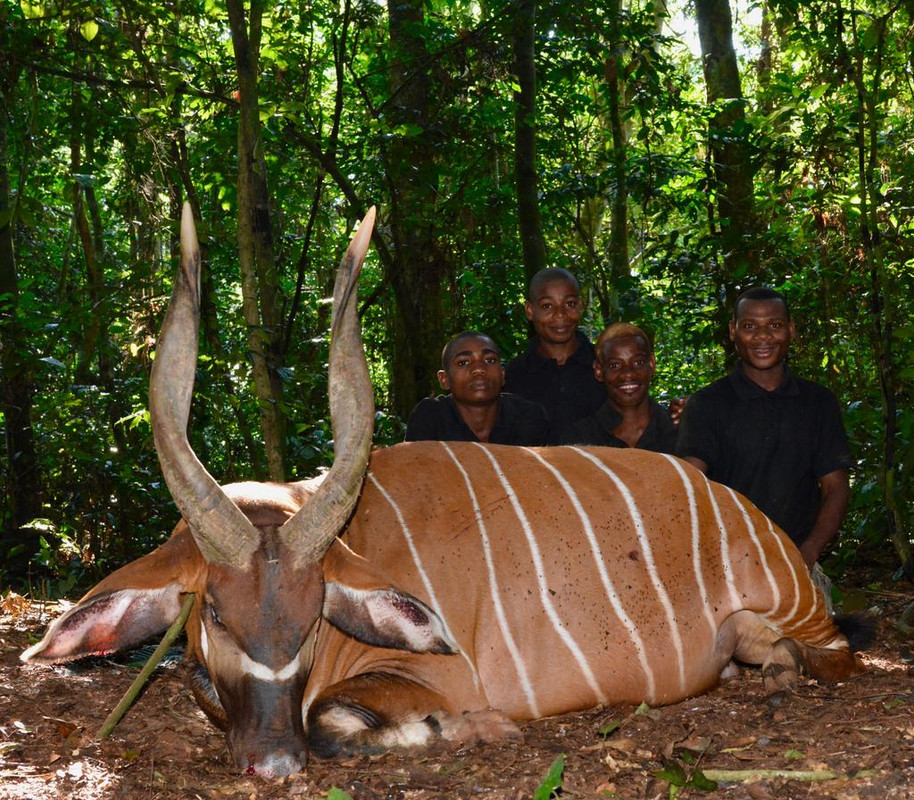 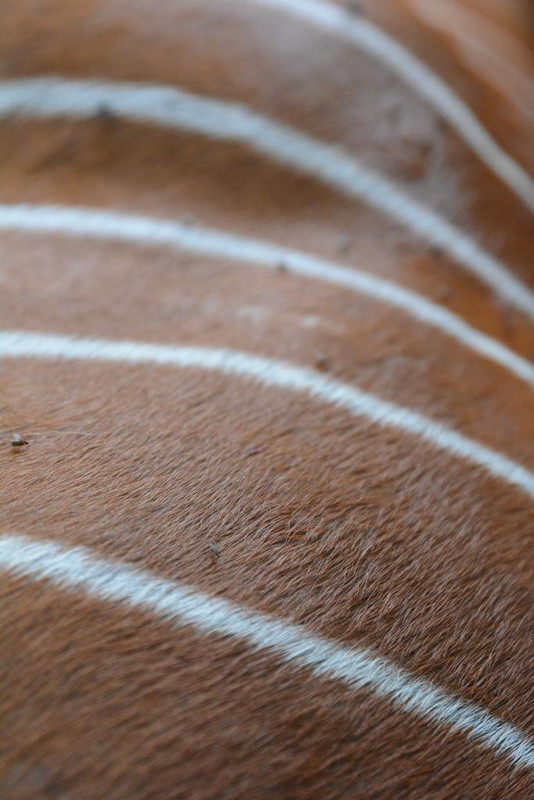 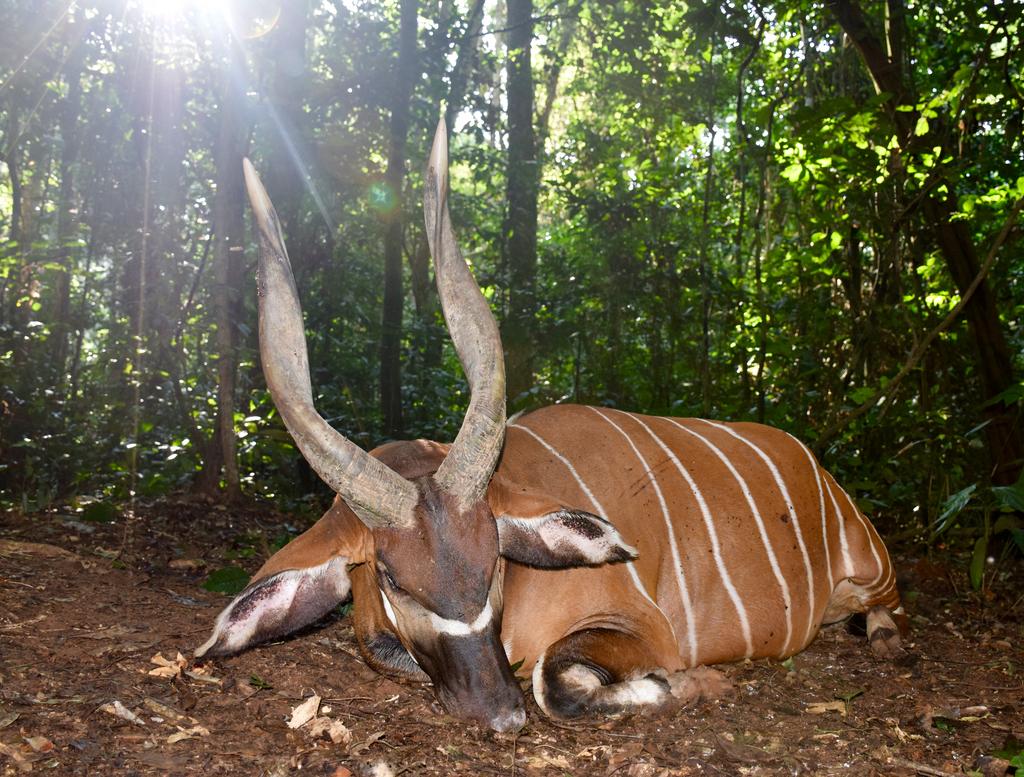 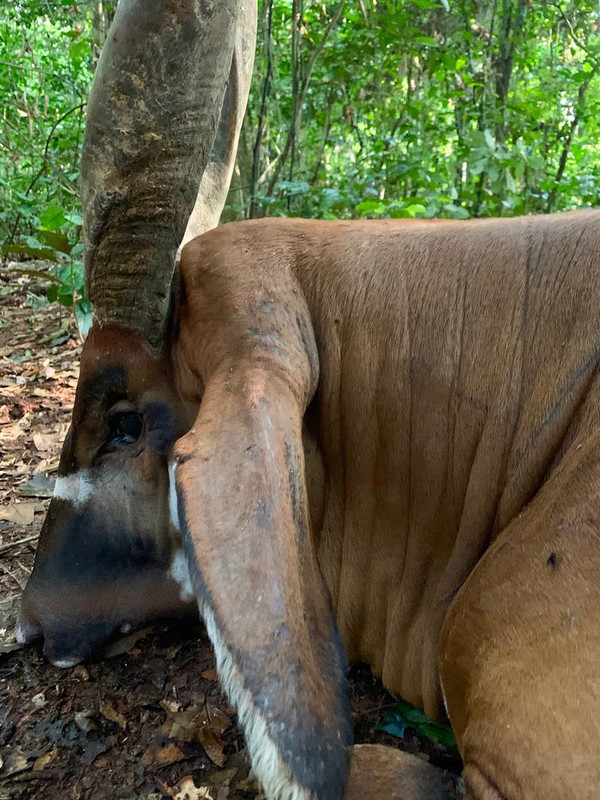 After many photos, the Baka begin to skin and quarter the bull which takes several hours. Their efficiency and strength is remarkable. Nothing is wasted and everything needed to haul the bull out is fashioned from leaves and vines provided by the forest. Within a few hours, we are back in the truck headed back to camp, singing the whole way… 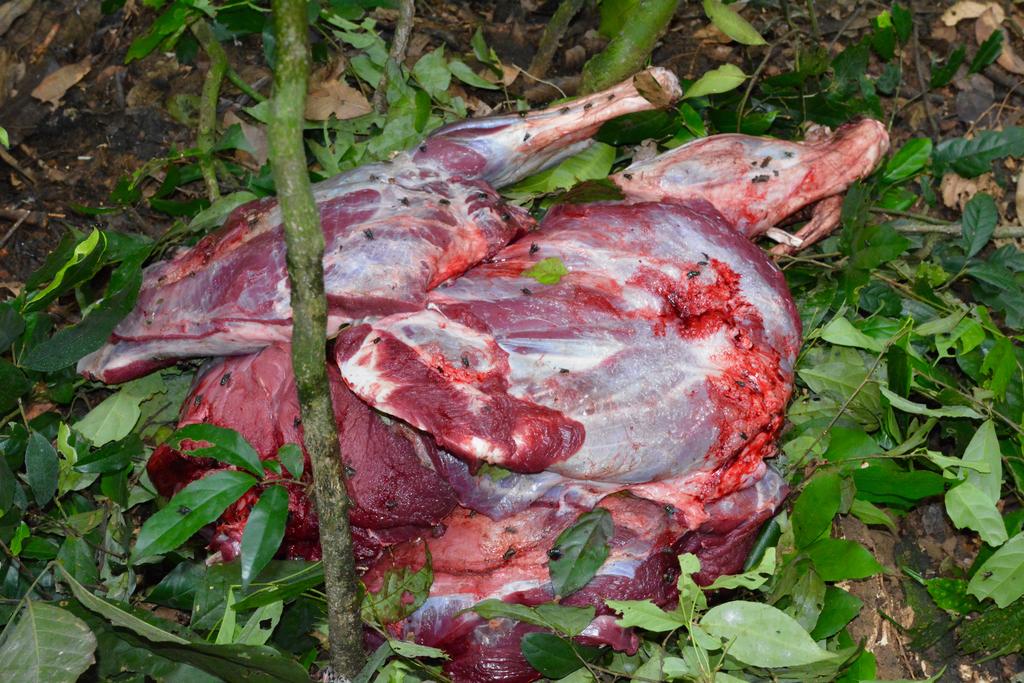 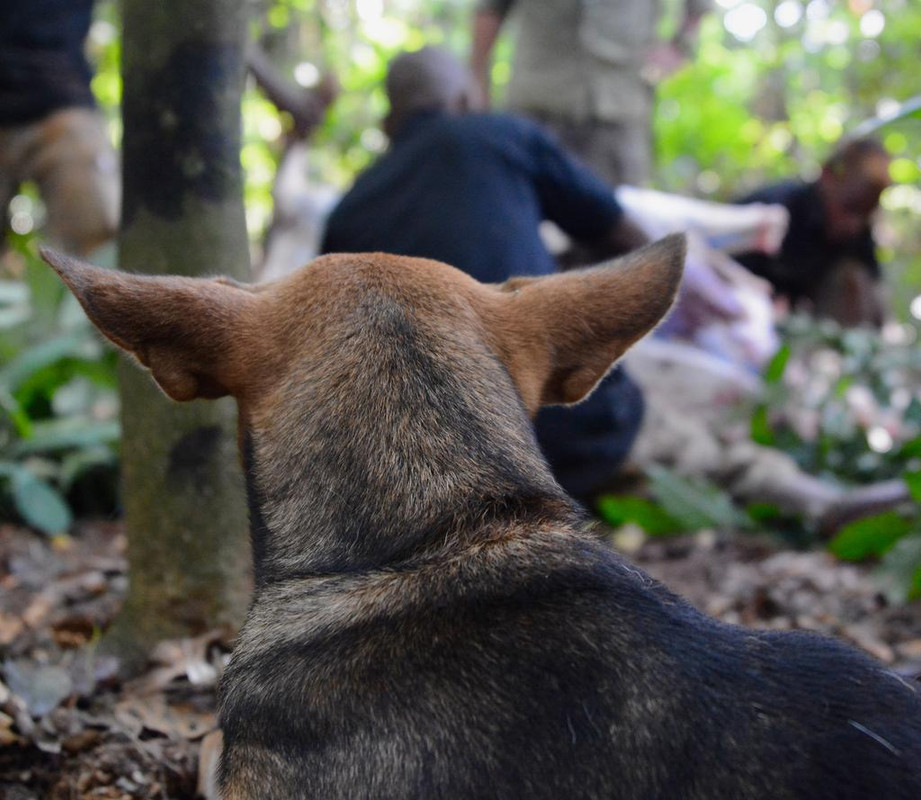 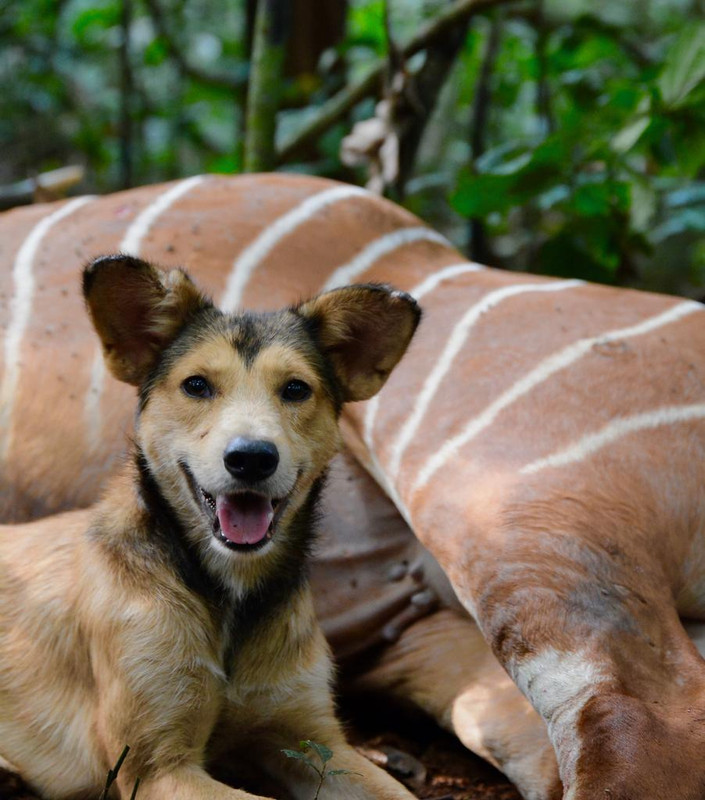 During the afternoon, I give each tracker a soccer ball and the games begin. Behind the chalets there is a large clearing with an umbrella tree in the center; this becomes the playing field. Everyone in camp is involved in the festivities, including Christophe and I. We launch balls high in the sky and laugh as they attempt headers. It was great fun and provided an afternoon full of laughs. Christophe took me back to the skinning shed to look at the mandible of my bongo. “He is much older than we thought, older than 12”. Several molars are completely worn down to the gum line! What an outstanding old bull! By the fireside this night, we toast champagne…a TalaTala tradition for each bongo. Dwarf Forest Buffalo Encouraged by how much buffalo sign we had seen on the first 5 days, we decide to refocus now that we have our bongo. During the mornings, we search for fresh buffalo sign and hunt duikers. The dwarf forest buffalo is an amazing animal, much smaller cousin to the other buffalo in Africa. By body size and weight, they are comparable to a mature bongo bull…sometimes smaller. Despite their small size, they are a force to be reckoned with, “Buffalo are scary shit”. Christophe points to a scar, akin to a thyroidectomy scar, on his lower neck. A buffalo gored him in the neck some years ago in Benin and left that scar as a reminder. Dwarf forest buffalo can be hunted by sitting over salines and bais, similar to sitatunga, or can be hunted by tracking with the dogs. However, Christophe does not want to take the pack leader. “He’s too good of a dog. I don’t want to lose him”. Obviously, this is a bit disconcerting…these buffalo are no joke. Unfortunately, the buffalo sign became sparse for us after we took the bongo with the exception of the morning of day 10. On this morning we saw a lot of sign at multiple salt licks. One of the last we checked had a huge buffalo bull track and “less than one hour” elephant sign. As we approached the saline, the trackers could hear movement in the nearby forest and we quickly made a plan. With haste, we set off along the buffalo tracks to find their beds in a dense thicket and then found where they had re-emerged. They fed down a road to a small clearing where they bedded again. Unfortunately, we were just too far behind them to have a reasonable chance at catching up to them now. I must say that the brief time we spent on the tracks was quite exciting. It is my first experience hunting buffalo but there was a tangible change in energy, focus, and demeanor amongst the whole team. Encountering a buffalo in this dense forest is nothing to joke about and requires the utmost respect! Duiker Hunting, My Roller Coaster Experience For the first half of the safari, the duikers were my nemesis. The first day we hunted them, the trackers called in several but I had difficulty getting a good view of them each time which was frustrating for all involved. Then the shooting troubles started… I had an absolutely terrible stretch of shooting, missing multiple duikers throughout the first week of the safari. We were all frustrated. The calling aspect was tremendously successful and we easily saw duiker on well over half our calling sites. However, my shooting was the downfall of our duiker success. At first we were using a Winchester pump, which I shot horridly with during the first few days. Christophe then suggested switching to the Beretta over-and-under in camp which did not seem to help at first but then things all came together on the 9th morning of the safari… Christophe had suggested several times that I am shooting high when shooting at the duiker. So this morning I took off my dunce cap and spent some extra time with the hold and feel of the Beretta over-and-under we are carrying. The length of pull is a bit short for me and so I decide I must hold the stock higher on the shoulder. My duiker shooting made a remarkable recovery…3 shots, 3 duiker! First an ancient old Peter’s duiker, then a nice male blue duiker, and finished with a a beautiful bay duiker. A wonderfully successful morning and Christophe reports this is the first time they have taken the 3 most common forest duikers in one morning! 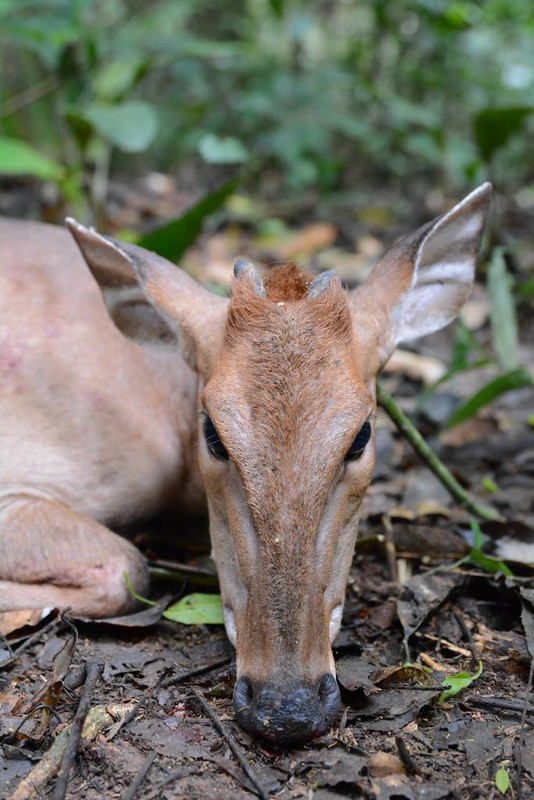 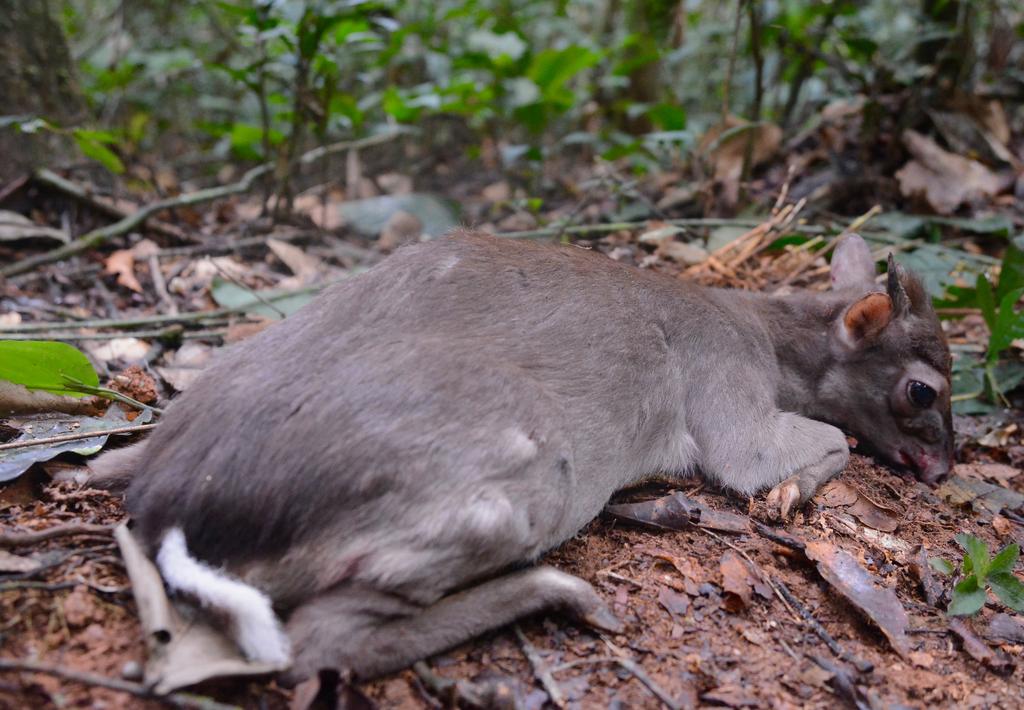 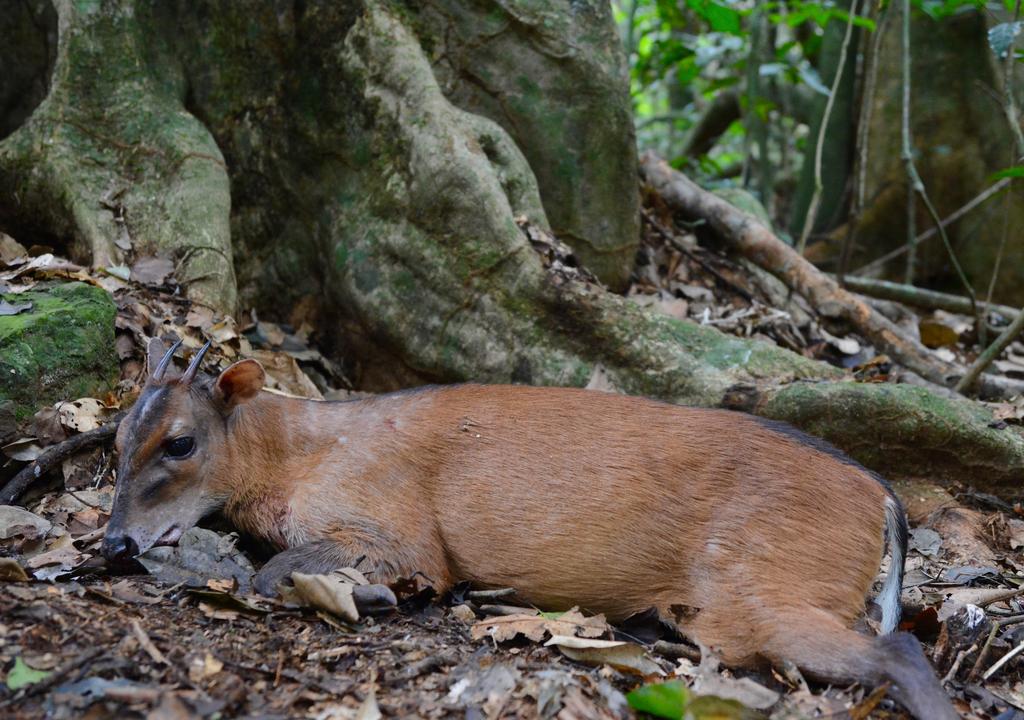 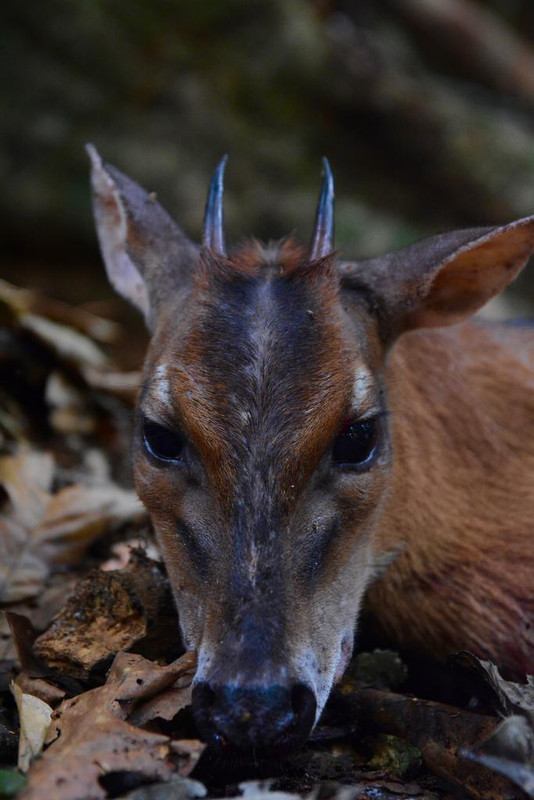 Forest Sitatunga…Ghosts of the Swamp As described above, our sitatunga hunting was focused on two separate bais, located about 300 meters from one another. The smaller bai holds a salt lick, small stream, and thick, tall grass. Overlooking the small bai is a very large machan which I would estimate to be about 20 x 10 feet. It has a covered roof, 4 walls, and circumferential shooting window. In total, we spend 5 nights in the large machan. For our comfort, the machan could house 3 cots each adorned with a mosquito net. We all slept very peacefully in the machan as the chorus of forest sounds eased us to sleep each night. The larger bai is a few hundred meters from the small bai with large machan. On the large bai, there is a centralized salt lick as well as a band of papyrus through the middle. Otherwise, the bai is largely covered by fern growth. Overlooking the bai is a less luxurious wooden platform when compared to our tree top Taj Mahal on the small bai. The small platform has a front shooting rail but otherwise no walls or roof. To get to the large bai, we must cross the river via a felled log followed by trudging through a swamp which often left us knee deep in mucky swamp water. After 4 uneventful all night stays in the large machan, we head back to gather our equipment, cots, and mosquito nets. As we look out across the bai, Christophe sighs, “I am very disappointed”. At the beginning of the safari Christophe was very optimistic we would get an opportunity at a sitatunga but thus far there has been little to no movement at this saline. We climb down, cross the river, and fetch the trail cameras. Alas, the past two evenings have been very eventful and the cameras show recent visitors including yellow-back duiker, female sitatunga, a young sitatunga bull, and most importantly, a big sitatunga bull! Back at the truck, Christophe and the Baka discuss the change of events. “Brian, we must try again tonight”. In complete agreement, we plan on returning tonight for another all night vigil… By 4:30 PM we have the large machan again set up for the night with our renewed hope. Relatively early, a female sitatunga appears with a youngster in tow. They are visible at the edge of the small bai with a bull “barking” just out of view. As much as we mentally coax him to appear, he never shows and eventually the female meanders off. These sitatunga bulls seem more like apparitions than animals! “Are you keen”? After a relaxing night of sleep in the machan, we awake just before first light. However, the first hour of shooting light reveals no visitors. Christophe and I trudge through the swamp to the large, more remote bai a few hundred yards away. As we settle in to the smaller platform tucked into a tree at the edge of the large bai, the Baka put on a “sitatunga drive”. They make a wide loop, paralleling the perimeter of the bai but are unable to flush anything into view. Dejected, we climb down for the platform and check the small, centralized saline in the large bai. Much to our surprise, it reveals numerous fresh sitatunga tracks and the Baka report numerous tracks along the edge of the bai as well. Christophe smiles, “Brian, I think we must try to sit here tonight. It’s going to be nasty. Are you keen?” It was not the most convincing sales pitch, however, I muster up a nod and smile. “The Baka are skeptical because of all the noise we just made. But still, our chances are better here than in camp”. Impossible to argue with his logic, we begin to make plans. Christophe asks the Baka to fashion a roof over the platform to house a tarp. They wander into the forest, machetes in hand, to collect branches and vines. Quickly they assemble supports and trusses to hold up a tarp roof. It is not the strongest appearing structure but effective. A few more shooting lanes are cut and we are ready for the afternoon.  We settle in to the platform with newly fashioned tarp roof. Not long in to our sit, a female and young sitatunga appear off to the left. Shortly thereafter, another female and youngster appear near the saline. Christophe picks up motion at about our 2 o’clock position, still within the cover of the forest. “Brian, it’s a huge sitatunga. He’s going to come”. A short fifteen minutes later, Christophe nudges me from my trance, “Brian, he’s coming to the salt by the females”. I get into position and the bull emerges from the papyrus. Alas, it is a young bull. Until he emerged from the papyrus, all that was visible was the tips of his horns. As nighttime takes away the last remaining light, we settle in for our “nasty” night. I doubt I slept more than 15 minutes the whole night but fully expected that would be the case. As dawn begins to trickle in, movement in the swamp and water to our right is easily audible. It is so loud that I expect buffalo or elephant to appear at any moment. Silence for what seems to be eternity (10-15 minutes in reality) is abruptly interrupted as I turn my head hard to the right. My eyes meet a large sitatunga with long horns. By no means am I an expert on judging sitatunga, however, I knew this was the one we were looking for. “Christophe, a big sitatunga just appeared on our right”. As his gaze shifted, he had a near identical reaction to mine. “Brian, get in position. That is a big bull!” He has appeared to the right of the platform with no shooting rail available, so I go to a seated position on the platform. Approximately one-half of the bull is obscured by dense ferns. The crosshairs settle just below the line where the ferns end and hide is visible. The rifle announces and the bull bucks like one would expect from a heart shot and disappears into the forest. “He is hit hard”. The Baka appear within 10 minutes and quickly navigate the swamp to where the bull was last seen and where we expected he would be stone dead. However, we hear crashing through the forest, “He’s not dead”. Shit. Fortunately, the bull was hit hard with a quick follow up and coup de grace finishing the job. The first shot was 2 inches too far back but still hit portions of the liver and stomach. The bull is magnificent. Perfectly designed to live in this seemingly inhospitable swamp. Long legs like a ballet dance with elongated, splayed hooves to seamlessly navigate through the muck. I’m astounded by the body size and brilliance of this animal. His perfect, lyre-shaped horns take your breath away…  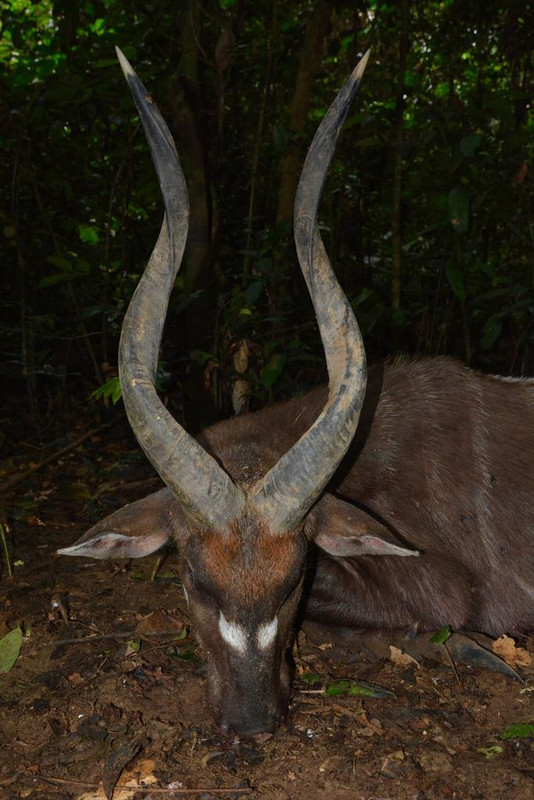 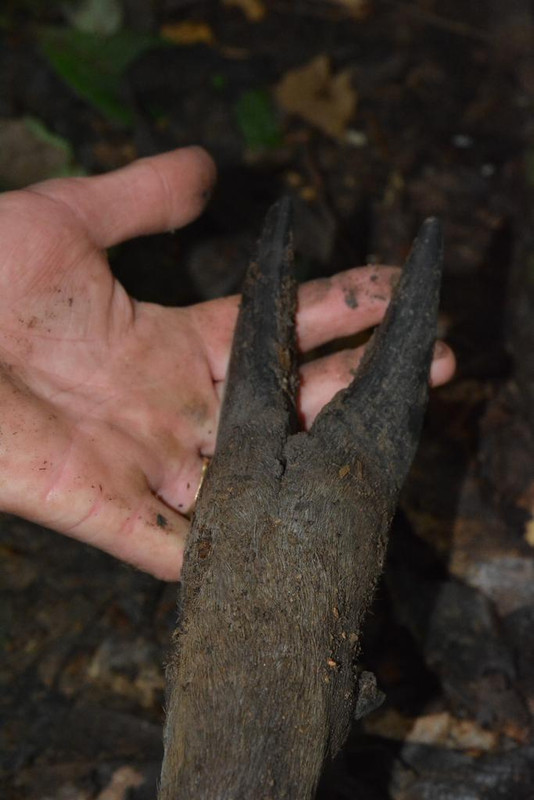 I did not report this earlier during the safari due to fear of a jinx. On our drive from Ouesso to camp, Christophe announced his expectations for the safari. “Bongo are easy. My goal is to get you a sitatunga”. At the time, I was taken back a little. Bongo was the goal and I did not want to look past him. As he has been the entire trip, Christophe was right! Other Forest Creatures… The forest is a miraculous place, full of life. We were blessed with the opportunity to see lowland gorillas 7 times during the safari. Most sightings were brief and fleeting, especially with the silverbacks. However, on a few occasions we got to watch female gorillas for 5-10 minutes as they stayed in the treetops above us. The silverbacks are truly one of the most impressive animals I have ever laid eyes on! 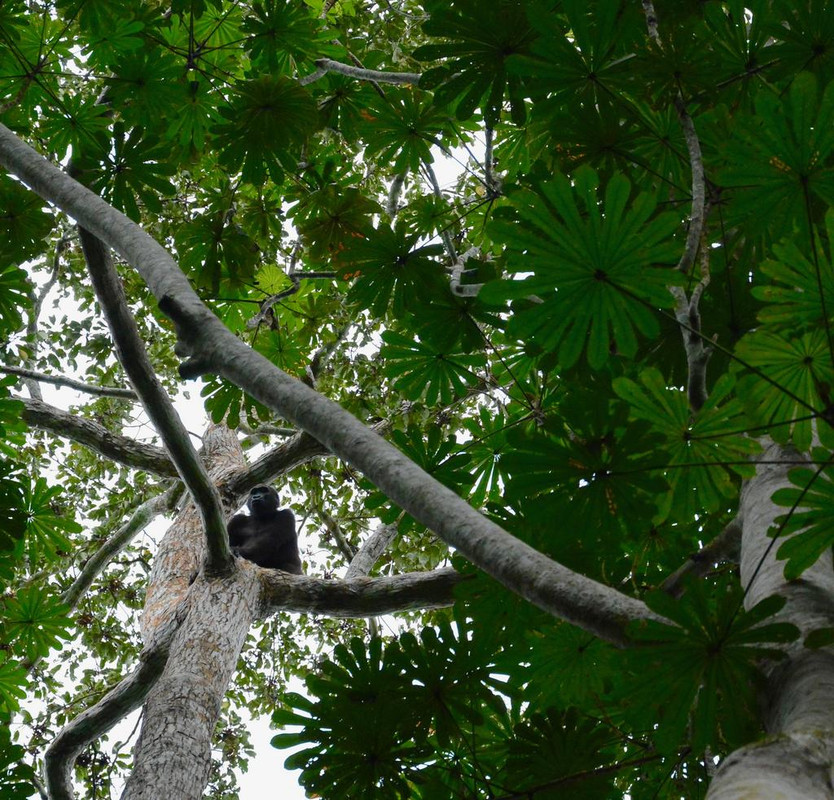 During our safari, we had an uncharacteristically high number of snake sightings. In total, we came across 5 different rhino vipers in the road. They are a beautiful snake, adorned with eerily effective camouflage. The snake sports an impressive girth, disproportionate to their length. Unfortunately, their venom can be quite deadly. They are a slow-moving snake, although, like the puff adder have a deadly fast strike. We actually hit these snakes with the jeep as they are terribly hard to see as you’re driving. However, the Baka were elated and each snake ended up in the pot! 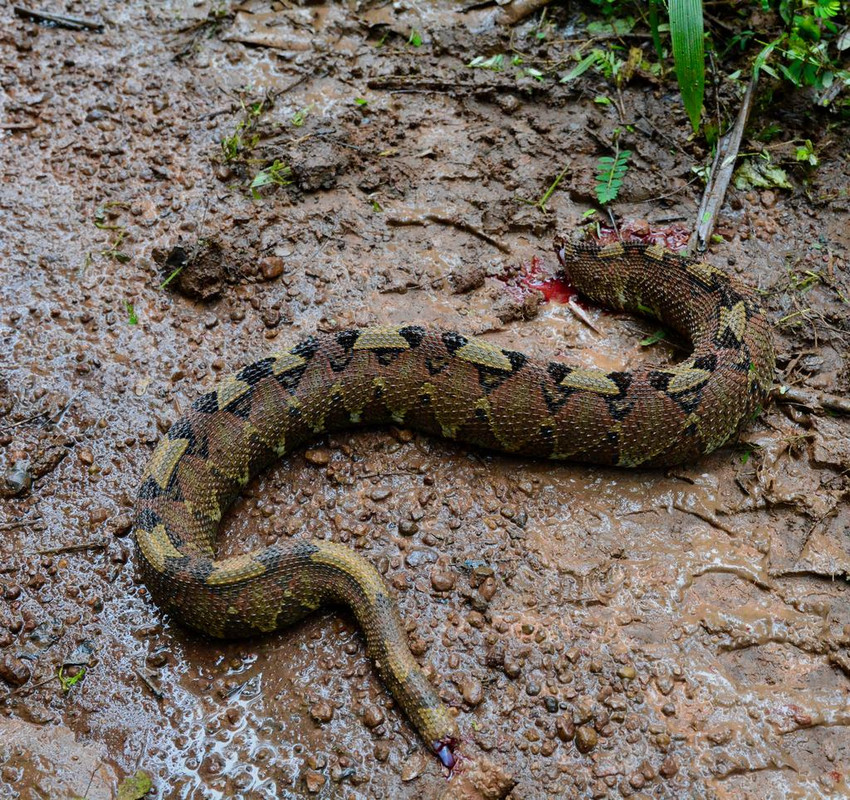 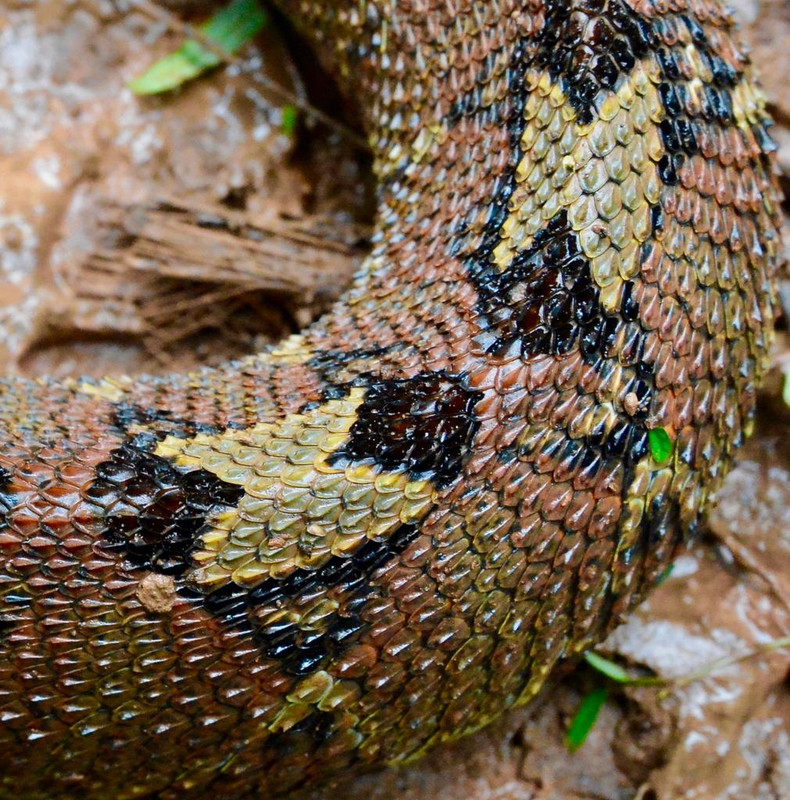 We also had a black mamba cross the road in front of us but did not investigate further! Gaboon vipers, forest cobras, green mambas, and pythons are also present but we did not see any during the trip. One morning we came across a small pangolin ambling down the road. It had been injured the night before with wounds on its left side and under its right front leg. We handled him carefully for a moment before letting him disappear into the forest, much to the dismay of our lead tracker Zemako who would have preferred him for dinner. Francolin frequently dodged the tires of the Land Cruiser and on several occasions we saw the forest guinea fowl which are beautiful. Overhead, there are multiple species of hornbill, some of which are very large. When the hornbills take off and glide by the sound like miniaturized jets passing through. The splendid blue turacos were seen and heard frequently overhead. Insect life is plentiful in the forest with large millipedes, some as long as your hand, frequently encountered. Red, brown, and black ants come in many sizes, although, they all seem to bite and can be rather unpleasant if they find their way up a pant leg or sleeve! A giant golden orb spider fashioned a brilliant yellow web across the road one morning. The spider is quite large and nightmare-inducing if you are not a fan of spider’s like myself. 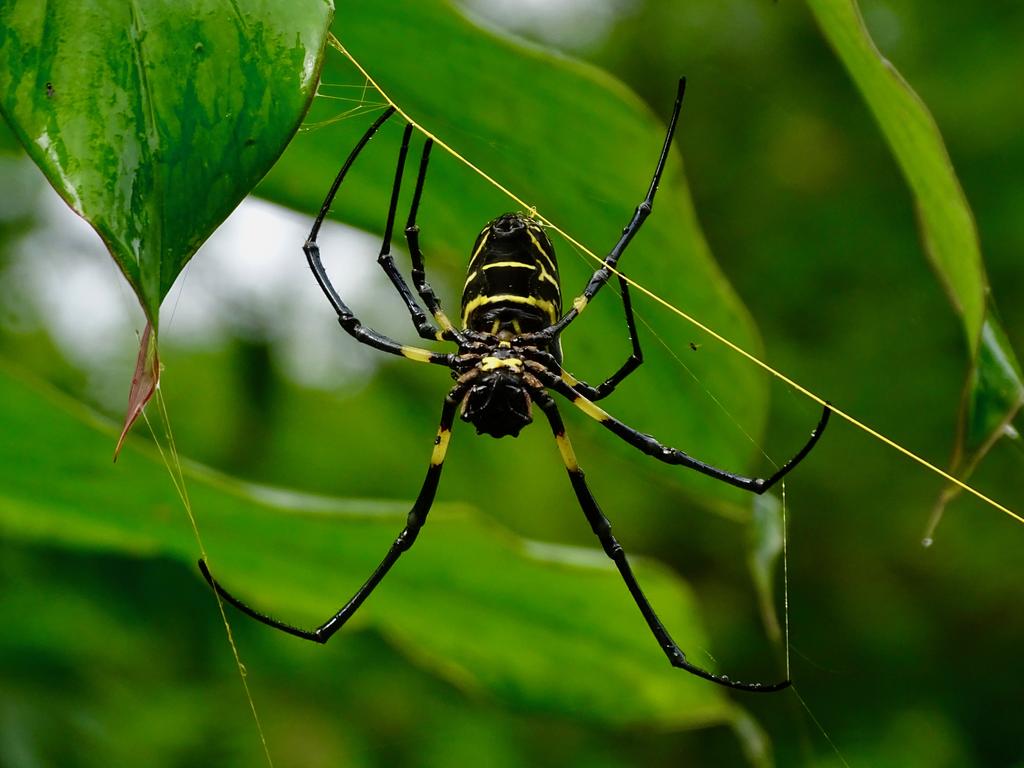 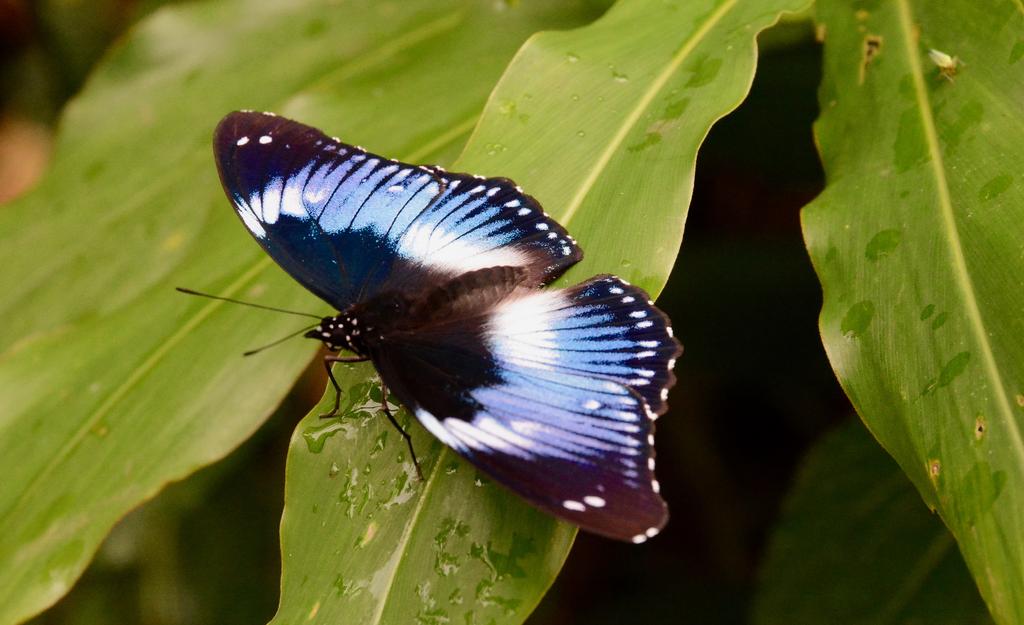 Last Night Celebration This evenings we have visitors to the camp from African Parks, including Erik Marav (former owner of Central African Wildlife Adventures). Erik is an impressive young man and truly an asset for conservation in Africa, currently serving as West African Regional Operations Manager for African Parks. It was a pleasure to meet and chat with him this evening. The Baka gather, sing, dance, and recreate the hunt around the fire while we enjoy champagne to celebrate the tremendously successful safari. Back to Brazzaville We are on the road early to head back to Ouesso and catch the Air Congo flight back to Brazzaville. As typical for central Africa, there is some delay as multiple officials look over our passports and bags. When traveling in this region of the world this is to be expected and your most useful tools are patience and smiles. The flight back to Brazzaville is in an outdated plane but otherwise passes uneventfully. Jean Luc meets us at the airport and we check back in at the GHS hotel. From our hotel room the mighty Congo river is visible. Jean Luc then takes us to Mami Wata, a nearby restaurant, which sits directly on the banks of the Congo and the outside seating gives us a great view across the river to neighboring Kinshasa, DRC. Unfortunately, there are no reasonable outgoing flights back to Paris today so we must wait until tomorrow evening for a flight out of the country. We made a quick trip to an indoor market the morning of our departure to look for some curios. Otherwise, we arrive at the airport a few hours before take off and say our goodbyes to Jean Luc. Anxious to get home, we began the first leg of the long road home… Final Thoughts Jean Luc Damy and Christophe Morio offer a superb hunting experience in the climax forests of northern Congo. The hunting is phenomenal within their 150,000 hectare concession (much of which still has not been hunted). The advanced age of the animals taken and sheer number of tracks and duiker sightings clearly indicate the undisturbed nature of this concession. The best word I can think of to describe the safari is “proper”. From top to bottom this is a first class operation run by first class people. I would give Congo Forest Safaris my highest recommendation to anyone and I am indebted to them for the wonderful experience! 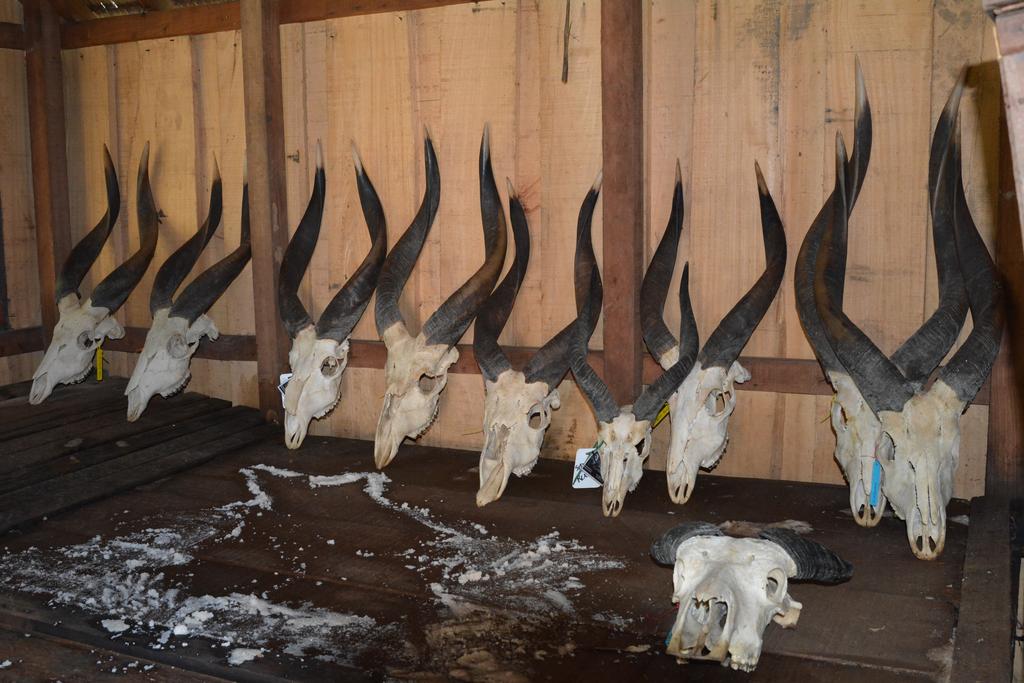 Truly it was a pleasure and honor to spend several weeks with Christophe Morio as my PH. The man is passionate about hunting, passionate about bongo, and deeply passionate about conservation of African game and their habitat. He is determined and we hunted remarkably hard for the duration of the safari. Without question, I was privileged to spend several weeks with one of the great professional hunters of our time. I would hunt with Christophe anywhere and hope to do so again in Benin in the near future. The climax forest of equatorial Africa is a special place; it is one of the true great hunting adventures on our fine planet. However, the forest is a tough. It is mentally exhausting and you must manage your expectations appropriately! You will not see large amounts of game due to the dense forest but game can appear at any time. Maintaining focus is often difficult as you may go several days without seeing a large game animal. The humidity can be oppressive at times but is manageable. Whether it be sweat, rain, or both, you will be wet while in the forest. Everything in that forest seems to want to take a piece out of you from ants, sweat bees, or thorns. Despite its difficulties, I loved the forest. Any success you have will be success that you earned and can leave with a genuine feeling of accomplishment. I want to take a moment to thank the fine folks on AR. I scoured prior bongo reports, asked questions, and reached out to many for advice. As always, AR and its members were a terrific resource for preparing for a forest safari! Finally, I have many thanks to give out for making this safari possible. The good Lord has provided me with more blessings than any one man truly deserves and that most certainly includes this safari. My gracious wife spent nearly 3 weeks wrangling our boys alone while I was away chasing my dreams. Without her, so many of the wonderful things in my life would not be possible. I am particularly blessed that my dad was able to make the trip with me and I pray that one day I can do the same with my boys. "The true test of a man's character is what he does when no one is watching". - John Wooden | ||
|
| One of Us |
Congratulations! You did really well, any Bongo is special, and that is a very nice Sitatunga! | |||
|
| One of Us |
Great report, some very nice trophies and wonderful photography. Thanks for posting this. Roger ___________________________ I'm a trophy hunter - until something better comes along. *we band of 45-70ers* | |||
|
| One of Us |
. PAGuardian, What a great adventure! Congratulations on a solid bongo and a superb sitatunga! Top quality photographs. Thanks for sharing. West Africa is indeed a special part of Africa! Charlie . "Up the ladders and down the snakes!" | |||
|
| One of Us |
Thank you for taking us to such a remarkable place. Such fine animals. Well done. Jeremy | |||
|
| One of Us |
Truly remarkable and unique hunting report. Spectacular trophies. Well played! Jesus saves, but Moses invests | |||
|
| One of Us |
Thanks for the exciting and thorough trip report! Glad you mastered the photo posting. Leopard, Hippo, Croc - Zambezi Valley, Zimbabwe, 2024 Reindeer & Geese, Iceland, 2023 Plains Game, Eastern Cape, 2023 Buff - Zambezi Valley, Zimbabwe, 2022 Muskox-Greenland, 2020 Roe buck and muntjac in England, 2019 Unkomaas Valley, RSA, 2019 Kaokoland, Namibia, 2017 Wild boar hunting in Sweden, 2016 Moose hunting in Sweden, 2014 How to post photos on AR | |||
|
| one of us |
Very interesting,congratulations and thanks for the nice report. | |||
|
| One of Us |
Awesome report, pics and trophies! Love that bongo. | |||
|
| One of Us |
Fantastic just fantastic! Good Hunting Carl Frederik | |||
|
| One of Us |
A proper report ... thanks mate. | |||
|
| one of us |
PAguardian, What a wonderful report! Congrats on some superb trophies. Mark MARK H. YOUNG MARK'S EXCLUSIVE ADVENTURES 7094 Oakleigh Dr. Las Vegas, NV 89110 Office 702-848-1693 Cell, Whats App, Signal 307-250-1156 PREFERRED E-mail markttc@msn.com Website: myexclusiveadventures.com Skype: markhyhunter Check us out on https://www.facebook.com/pages...ures/627027353990716 | |||
|
| One of Us |
Thank you for posting, the rain forest in the Congo is a wonderful place. | |||
|
| One of Us |
Well done!!!!! | |||
|
| One of Us |
Outstanding report and trophies. Thanks for taking us along! JEB Katy, TX Already I was beginning to fall into the African way of thinking: That if you properly respect what you are after, and shoot it cleanly and on the animal's terrain, if you imprison in your mind all the wonder of the day from sky to smell to breeze to flowers—then you have not merely killed an animal. You have lent immortality to a beast you have killed because you loved him and wanted him forever so that you could always recapture the day - Robert Ruark DSC Life Member NRA Life Member | |||
|
One of Us |
One of the most engaging hunt reports I've ever read. I feel like the fire has been lit to do a similar hunt. Thanks for the report. What a grand adventure. | |||
|
| one of us |
Great report and beautiful trophies! I noticed that you said that there were chalets with air-conditioning in camp but you spent a lot of nights out in the machans. What was the temperature and humidity like out there? Were the mosquitoes and/or biting flies bad? Frank "I don't know what there is about buffalo that frightens me so.....He looks like he hates you personally. He looks like you owe him money." - Robert Ruark, Horn of the Hunter, 1953 NRA Life, SAF Life, CRPA Life, DRSS lite | |||
|
| One of Us |
Simply outstanding! Great report and fantastic pictures! | |||
|
| One of Us |
Frank, Overnights in the machan were very comfortable as the heat and humidity significantly decrease when the sun goes down. The first few hours in the machan are definitely the most uncomfortable as the sun is still up when you settle in for the evening. As for mosquitoes, they also were not too bad. I left with a few mosquito bites but nothing terrible. Malaria prophylaxis is an absolute necessity here though as it is a high risk region of Africa. The large machan where we spent most nights was actually large enough to fit cots with mosquito netting! Biting flies/bees were only an issue when we had an animal down. Without question, I got more bites while we were skinning the sitatunga than the other 12 days of the safari. "The true test of a man's character is what he does when no one is watching". - John Wooden | |||
|
| one of us |
Congratulations on an exceptional adventure in the Congo! The trophies were icing on the cake. Well done and thanks for taking time to post a report! On the plains of hesitation lie the bleached bones of ten thousand, who on the dawn of victory lay down their weary heads resting, and there resting, died. If you can talk with crowds and keep your virtue, Or walk with Kings - nor lose the common touch... Yours is the Earth and everything that's in it, And - which is more - you'll be a Man, my son! - Rudyard Kipling Life grows grim without senseless indulgence. | |||
|
| One of Us |
Thank you for sharing this fantastic hunt report. One of the most well written I’ve seen in a while. Congratulations on an outstanding safari! | |||
|
| One of Us |
One of the better reports I have read. Thank you for sharing. DRSS Searcy 470 NE | |||
|
| one of us |
Thanks for the information, you almost make it sound like fun. (I'm not a jungle person) Frank "I don't know what there is about buffalo that frightens me so.....He looks like he hates you personally. He looks like you owe him money." - Robert Ruark, Horn of the Hunter, 1953 NRA Life, SAF Life, CRPA Life, DRSS lite | |||
|
| One of Us |
I must say that as amazing as this hunt looked to be, it was one of the most well written and detailed reports that I have read on this site. This report was at or near the top of anything that I have read. Great job and congratulations on an amazing hunt! | |||
|
| One of Us |
Amazing hunt!! How long were you there? You mentioned several weeks. | |||
|
| One of Us |
In total, we were in the country 16 days (13 hunting days for the safari). "The true test of a man's character is what he does when no one is watching". - John Wooden | |||
|
| One of Us |
Amazing report and well done...Christophe is now 100% on Bongo this year lets make a plan | |||
|
| One of Us |
Well done sir. Congrats on some well earned trophies. Bruce | |||
|
| One of Us |
That was simply outstanding. An absolutely amazing hunt and written superbly. I like your attitude. I'd hunt with you any time. We share a similar outlook I believe. Proper is certainly the right word for this safari. Thank you for sharing your experience. | |||
|
| One of Us |
~~~~~~~~~~~~~~~~~~~~~~~~~~~~~~~~~~~~~~~~ J. Lane Easter, DVM A born Texan has instilled in his system a mind-set of no retreat or no surrender. I wish everyone the world over had the dominating spirit that motivates Texans.– Billy Clayton, Speaker of the Texas House No state commands such fierce pride and loyalty. Lesser mortals are pitied for their misfortune in not being born in Texas.— Queen Elizabeth II on her visit to Texas in May, 1991. | |||
|
| One of Us |
REALLY excellent, well written and exciting report. Thanks!! | |||
|
| One of Us |
Amazing adventure and hunt one of the best reports I have read on this site | |||
|
| One of Us |
What a great adventure. A Bucket List for sure!!! | |||
|
| One of Us |
Incredible. The hunt of my dreams. Congratulations on your truly amazing trophies. | |||
|
| One of Us |
That is just wonderful. Congrats on an amazing adventure. I have been thinking about doing a Benin hunt with Christophe for a couple of years. | |||
|
| One of Us |
Without question, hunting Benin with Christophe would be a first class safari. They take some tremendous buffalo from their concession in Benin. I'm hoping to go there myself within the next few years! "The true test of a man's character is what he does when no one is watching". - John Wooden | |||
|
| One of Us |
| |||
|
| one of us |
Incredible! Thanks for taking the time to share. Someday.... Ski+3 Whitefish, MT | |||
|
| One of Us |
I was by your side while reading your report....so very well done! Great trophies to boot! As many have stated..thanks for sharing your adventure with the AR family! Skip Nantz | |||
|
| One of Us |
Fantastic report, thank you. | |||
|
| Powered by Social Strata | Page 1 2 |
| Please Wait. Your request is being processed... |
|
 The Accurate Reloading Forums
The Accurate Reloading Forums  THE ACCURATE RELOADING.COM FORUMS
THE ACCURATE RELOADING.COM FORUMS  Hunting
Hunting  Hunting Reports - Africa
Hunting Reports - Africa  Congo Forest Safaris - The Forest Experience!
Congo Forest Safaris - The Forest Experience!

Visit our on-line store for AR Memorabilia

